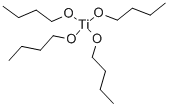Titanium , 99.99%metalsbasis, ≥300 , 7440-32-6
CAS NO.:7440-32-6
Empirical Formula: Ti
Molecular Weight: 47.87
MDL number: MFCD00011264
EINECS: 231-142-3
PRODUCT Properties
| Melting point: | 1660 °C (lit.) |
| Boiling point: | 3287 °C (lit.) |
| Density | 4.5 g/mL at 25 °C (lit.) |
| bulk density | 1260kg/m3 |
| Flash point: | 0°C |
| storage temp. | no restrictions. |
| form | wire |
| color | Silver-gray |
| Specific Gravity | 4.5 |
| PH | 5-8 (50g/L in H2O, suspension) |
| Flame Color | Silver-white |
| Resistivity | 42.0 μΩ-cm, 20°C |
| Water Solubility | Insoluble in water. |
| Merck | 13,9547 |
| Exposure limits | ACGIH: TWA 2.5 mg/m3 NIOSH: IDLH 250 mg/m3 |
| Stability: | Stable. Dust is thought to be spontaneously flammable, and may form an explosive mixture with air. Flammable solid. Incompatible with mineral acids, halogens, carbon dioxide, strong oxidizing agents. |
| InChIKey | RTAQQCXQSZGOHL-UHFFFAOYSA-N |
| CAS DataBase Reference | 7440-32-6(CAS DataBase Reference) |
| EPA Substance Registry System | Titanium (7440-32-6) |
Description and Uses
Titanium was discovered by the Reverend William Gregor in 1791, and is named after the ‘Titans’ of Greek mythology. The metal was not isolated in a pure state until 1910, and useful quantities were not available for industrial applications until 1946, when an economical purification process was developed.
Given titanium’s lightness, strength, and resistance to corrosion and high temperatures, itsmost common use is in alloys with other metals for constructing aircraft, jet engines, and missiles. Its alloys also make excellent armor plates for tanks and warships. It is the major metalused for constructing the stealth aircraft that are difficult to detect by radar.Titanium’s noncorrosive and lightweight properties make it useful in the manufacture oflaboratory and medical equipment that will withstand acid and halogen salt corrosion. Thesesame properties make it an excellent metal for surgical pins and screws in the repair of brokenbones and joints.It has many other uses as an abrasive, as an ingredient of cements, and as a paint pigmentin the oxide form and in the paper and ink industries, in batteries for space vehicles, andwherever a metal is needed to resist chlorine (seawater) corrosion.
Safety
| Symbol(GHS) |  GHS02 |
| Signal word | Danger |
| Hazard statements | H228 |
| Precautionary statements | P210-P240-P241-P280-P370+P378 |
| Hazard Codes | F,Xi |
| Risk Statements | 20/21/22-11-17-36/38 |
| Safety Statements | 16-36/37/39-33-27-26-6-43 |
| RIDADR | UN 2878 4.1/PG 3 |
| WGK Germany | 3 |
| RTECS | XR1700000 |
| F | 10 |
| Autoignition Temperature | 860 °F |
| TSCA | Yes |
| HazardClass | 4.2 |
| PackingGroup | III |
| HS Code | 81089020 |
| Hazardous Substances Data | 7440-32-6(Hazardous Substances Data) |



![DICHLORO[RAC-ETHYLENEBIS(4,5,6,7-TETRAHYDRO-1-INDENYL)]TITANIUM(IV)](https://img.chemicalbook.com/CAS/GIF/112531-75-6.gif)

